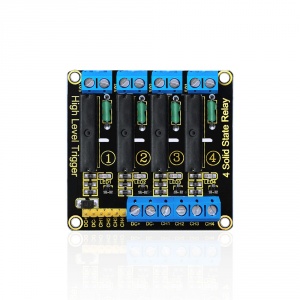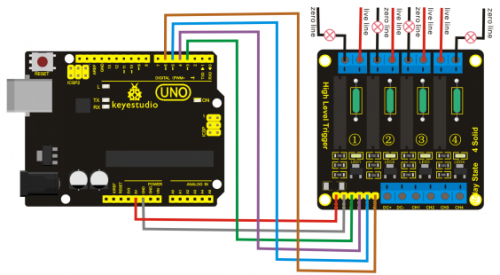Ks0265 keyestudio Four-channel Solid State Relay Module
Keyestudio Four-channel Solid State Relay Module
Introduction
Keyestudio two-channel solid state relay is a low level and effective solid state relay, that is to say, the input control signals is the low level (0-1.5 V), the relay is on; while the input control signal is high level (3-5 V), the relay is off. Solid State Relay is a new kind of contactless switching device which is composed of all solid state electronic components. Compared with the electromagnetic relay, its reliability is more higher, with the features of non-contact, long service life, fast and less outside interference. The output control terminal of the keyestudio solid-state relay must be connected to the circuit, and its working current needs to be bigger than 50mA, so that the solid state relay can be disconnected normally.
Performance Parameters
- Electrical parameters:
| Voltage | Static Current | Working Current | Trigger Voltage | Trigger Current | |
|---|---|---|---|---|---|
| Channel 1 | DC 5V | 0mA | 12.5mA | 3.3-5V | 2mA |
| Channel 2 | DC 5V | 0mA | 12.5mA | 3.3-5V | 2mA |
| Channel 3 | DC 5V | 0mA | 12.5mA | 3.3-5V | 2mA |
| Channel 4 | DC 5V | 0mA | 12.5mA | 3.3-5V | 2mA |
- Output port : AC240V/2A
Connection Diagram
Sample Code
int BASE = 3 ; //The first relay I/O port
int NUM = 4; //Total number of relay
void setup()
{
for (int i = BASE; i < BASE + NUM; i ++)
{
pinMode(i, OUTPUT); //Set the digital I/O port to output
}
}
void loop()
{
for (int i = BASE; i < BASE + NUM; i ++)
{
digitalWrite(i, HIGH); //Set the digital I/O port outputs to "HIGH", that is, gradually open
delay(200); //delay
}
for (int i = BASE; i < BASE + NUM; i ++)
{
digitalWrite(i, LOW); //Set the digital I/O port outputs to "LOW", that is, gradually close relay
delay(200); //delay
}
}
Result
Wiring as the above image, after power-on, the four-channel solid state relays are first connected and then broken successively, which is cycling alternately.
Resource
Datasheet http://www.keyestudio.com/files/index/download/id/1500516950/
Buy from
http://www.keyestudio.com/keyestudio-four-channel-solid-state-relay.html

